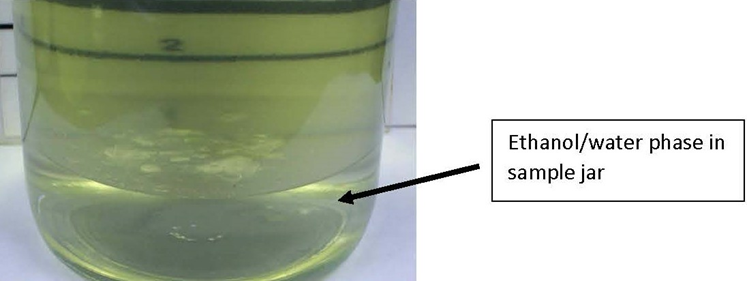Ethanol enriched fuel continues to have its challenges. It is both hydrophilic – easily dissolves in water and hygroscopic – water absorbing. Water is always present in some form, at some level often found suspended in ethanol blended fuel until it becomes heavy enough to drop out. Ethanol and water are miscible. That is they dissolve in each other forming a bond. Since ethanol is lighter than conventional gasoline, it remains suspended in fuel unless enough water bonds to it. Because water is heavier than fuel, enough bonded water will drag the ethanol to the tank bottom. This is phase separation. At the saturation stage fuel appears hazy, clogs filters and shuts down engines. It only takes .398% water – less than 20 gallons of water in 5,000 gallons of fuel for phase separation to occur. While technology is getting better, tank monitoring systems and water finding paste do fail. Bottom sampling is the best method for determining phase separation.
The Problem with Water
There are many ways water can enter a fuel system. It can enter through fuel delivery, condensation, leaky caps or seals or perforations in tanks and lines. The speed at which water enters fuel determines how quickly it becomes dissolved or emulsified. Very small amounts of dissolved water may not immediately cause fuel to be cloudy. If enough accumulates over time, the fuel will become cloud and eventually phase separate
| SOURCE OF WATER INTRUSION | RATE OF WATER FLOW |
| Water in delivery of fuel | Instant |
| Water in delivery of spill bucket released | Quick |
| Delivery riser open and rain water entering | Quick |
| Hole in vent cap or line | Varies with Hole Size |
| Leaky tank | Slow |
| Leaky spill containment system | Slow |
| Condensation – Water Vapor | Slow |
Rapid flowing water entering a storage tank causing agitation to the fuel will result in instant absorption resulting in highly emulsified fuel – instant phase separation. In contrast a slow leak may take weeks to phase separate. Depending on the amount of water, the fuel may range from dissolved to emulsified. Free water is the type commonly found on the bottom of tanks during complete phase separation. Fully phase separated water will pull as much as 90% of the ethanol out of the fuel, leaving you with out of spec fuel. Once separated, the fuel must be disposed of or remediated.
Protecting Ethanol Enriched Fuel from Phase Separation
Disposal and remediation of phase separated fuel is expensive. Its much cheaper to manage your fuel and fuel system than deal with the effects of phase separation. How do you avoid phase separation issues?
- Complete monthly fuel system inspections, including bottom sampling the fuel. At the first sign of water, remove it and find out where it is coming from. If it is a system leak, fix it. If the problem stems from condensation, monitor future accumulations over time and make a plan to keep your fuel dry. Some fuel systems are more susceptible to condensation than others. Stay ahead of water accumulation.
- Perform yearly line and tank tightness tests to assure your system is sealed and properly maintained. If a leak is found, have it repaired.
- Consider using a quality fuel additive specially formulated to help control the negative effects of ethanol. Using Biobor®EB in your fuel will help prevent the problem by keeping ethanol suspended in the fuel. It protects the fuel from water bonding. It also stabilizes the fuel, cleans the engine and adds lubricity.
Remember to test, treat and protect your fuel with Biobor®.

The Biobor® family of additives includes diesel fuel and gasoline products designed to remediate, stabilize, clean and enhance fuel. If you manage fuel and fuel systems, and are not using Biobor® additives as a way to reduce costs, downtime, liabilities and risk, contact us and learn how we can help. If you are using someone else’s products find out why you need to make the change to Biobor®. Join the Biobor®Revolution and be a part of the Biobor®Advantage.
Follow BioborShare the Post









Is there a paste for testing the percentage of ethanol in gas underground storage tanks?
Filters that are rated for 10% are slowing down after 15-20 gals ran thru
No there is no paste, but there are field testers that can be purchased online. I cannot attest to how accurate they are. If you have water sensing filters and your fuel flow is slowing down, you likely have some level of water content in your fuel. Feel free to contact me at peakins@biobor.com. I am more than happy to help.
Is there an additive to separate Gasoline out of Diesel Fuel?
Unfortunately not. The only way to separate them is to have the product reprocessed through a transmix plant. It’s an expensive process and usually only done in large quantities. If you would like additional information feel free to contact me at peakins@bioborcom.